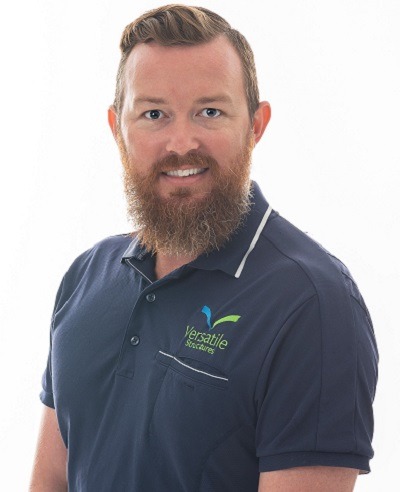YOU ARE HERE:
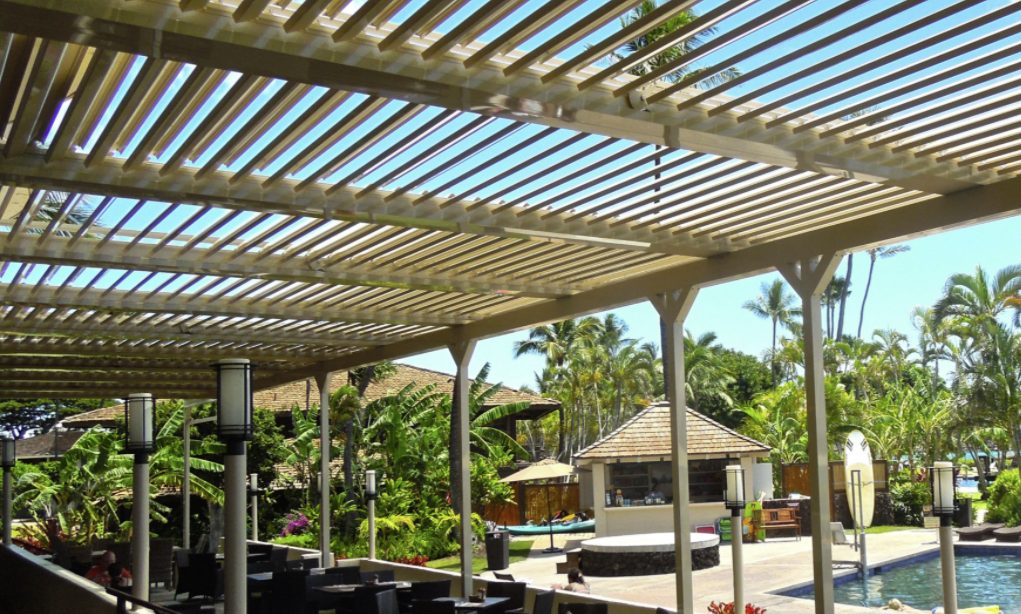
The many awning types and their benefits
Jamie Howard In Awnings & Blinds
Queensland’s tropical climate is ideal to embrace an outdoor lifestyle, with businesses and homeowners in Brisbane, Gold Coast and the Sunshine Coast taking advantage of the opportunity to design beautiful outdoor living areas that are protected from the summer heat and tropical rain.
Awnings are ideal solutions to create indoor-outdoor living areas and are an investment for any business or home as they add eye-catching aesthetic accents, and practical by reducing energy bills and protecting interiors from heat gain. Businesses have an additional benefit of increasing their retail footprint and turnover, by creating protected outside areas for their customers to dine and relax at.
However, with many different types of commercial shade sails, commercial awnings, industrial shade structures, fabrics, and colours available that it is not always easy to determine which outdoor awning is the best solution for your project. In this article, we aim to cover everything you need to know, from the different awning types and their applications, to which type of fabric is best for you and more.
Knowing the difference between the various awning types and their benefits will help you to make an informed decision when next investing in your property.
How many types of awnings are there?
While exploring awning options, you’ll discover there are four main awning types namely
- Retractable
- Motorized
- Fixed
- Portable
Which type of awning is best?
With so many different types of commercial shade sails and awnings to choose from, which is best? Ultimately it comes down to your requirements and not settling for less. Working with a shade sail specialist that can create a custom-designed solution for you, ensures the perfect aesthetics and functionality for your outdoor space, while also ensuring you the best quality and return on investment for your budget.
How do I choose an awning?
When it comes to choosing an awning, you need to consider the type of area you would like to cover and have knowledge of the weather exposure of your property in terms of the amount of rain and wind strength the awning must withstand when fully extended, the sun path and more. A specialist custom shade sail provider has the knowledge and experience to present you with options best suited to your needs.
RETRACTABLE AWNINGS
Retractable awnings include folding arms and motorised retractable awning solutions.
Retractable folding arm awnings
aka Folding arm, Pivot arm, and Auto-lock arm awnings
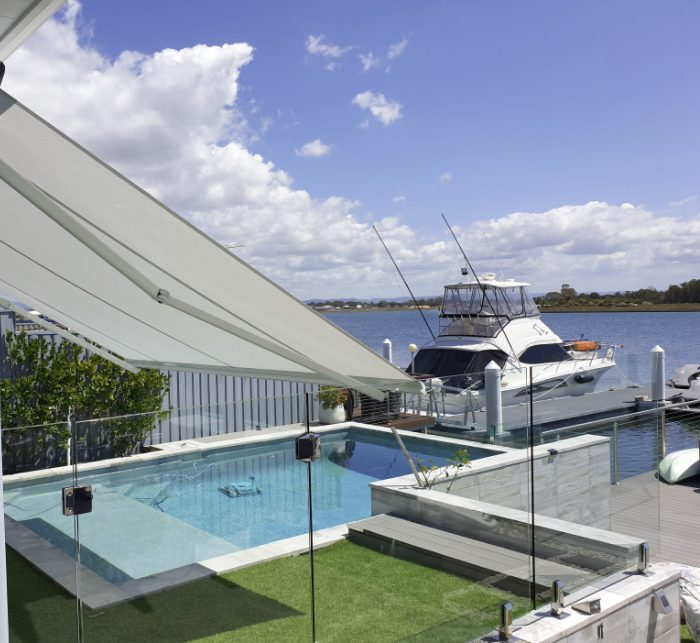
If versatility and shade control is important to you, retractable outdoor awnings are the most versatile solutions available, as they can be adjusted according to your needs. Being wall-mounted and operated automatically or manually, folding arm awnings can be expanded to offer full coverage in harsh light or retracted to enjoy a soft sunset glow.
Studies show that well-installed awnings can block up to 80% of heat entering through windows can save up 69% in electricity costs making it a smart investment.
Retractable awnings are ideal for decks, patios, outdoor entertainment spaces.
Retractable awning types
There are three types of awnings to consider
- Full Cassette awnings are fully enclosed by a headbox that protects the awning fabric, arms and roller mechanism when retracted
- Semi-Cassette awnings have a 3/4 cassette housing protect the fabric and components
- Standard awnings have no cassette headbox, leaving the fabric and components exposed to the elements
What material is best for retractable awnings?
When it comes to retractable awnings, Vinyl and Acrylic are the best options. It is important to keep in mind that darker fabrics absorb more heat and can make outdoor spaces warmer, while lighter coloured fabrics reflect the harmful, hot UV rays.
Vinyl, or polyvinyl chloride (PVC), is a synthetic material made from ethylene found in crude oil and chlorine found in regular salt. When combined, they form polyvinyl chloride (PVC) resin, or Vinyl as we know it and have proven to be the most effective material to use for medium to large awnings due to their outstanding durability and weather-resistant properties.
Acrylic is a synthetic fibre made from a polymer called polyacrylonitrile that can imitate fabrics like cotton. Acrylic-coated and acrylic synthetic fabrics are largely used to make retractable awnings because of their durability. This material tends to repel water and resist fading more effectively.
Benefits of retractable awnings
- Adds functionality to a property with unobstructed posts or beams
- Easy to use either manually or motorised
- Offers flexibility to suit your needs
- Reliable, cost-effective, and low maintenance
- Saves on energy (heating/cooling) costs
RETRACTABLE ROOF AWNINGS
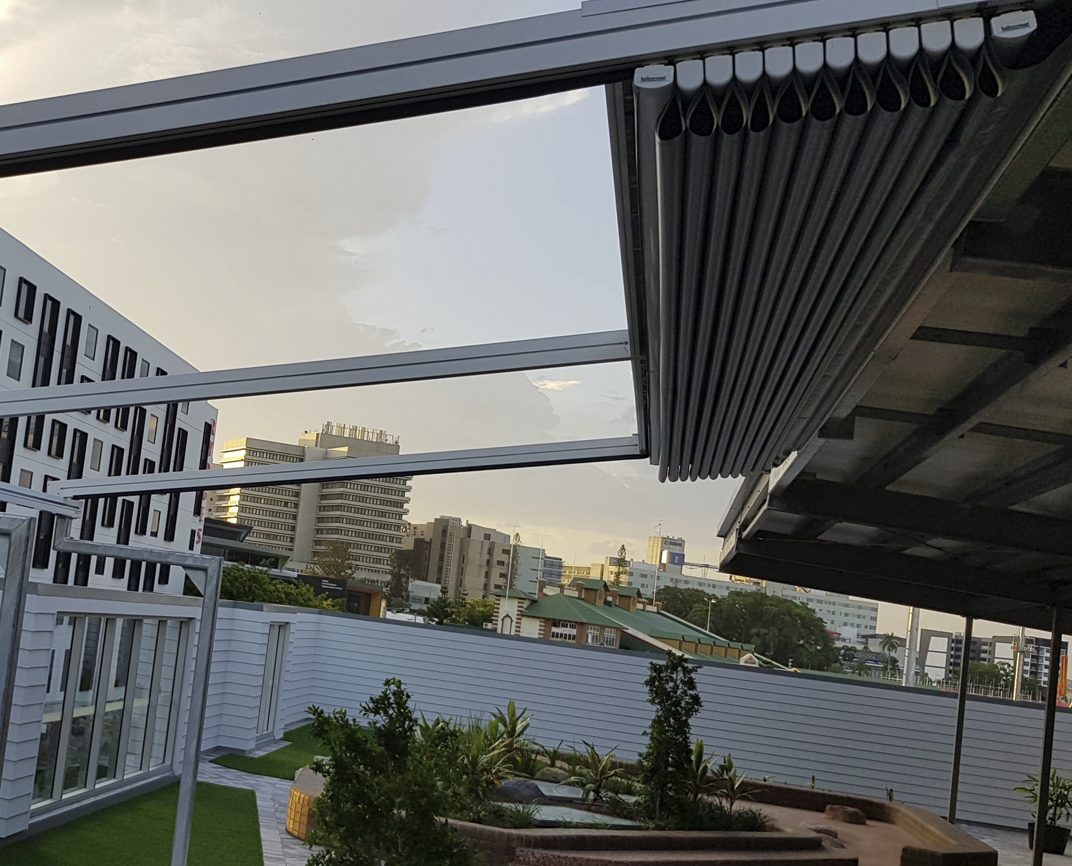
Retractable roof awnings retract concertina style by folding the fabric back in pleats and solving the challenges with wind and rain that folding arm awnings are not able to. Engineered to withstand wind speeds of up to 117km/hr, retractable roof awnings add an outdoor room for all seasons with optimum weather protection all year round. Unlike fixed tension shade sail systems, tension with a retractable roof system is held in the fabric and not the structure, resulting in lower construction costs with the flexibility of creating an outdoor or indoor area.
Additional options are to close the sides with glass or fabric screens as well as have LED lights and heating systems added.
Retractable roof awnings are ideal for decks, patios, outdoor entertainment spaces.
Fabric types
All retractable roof awning fabrics aim to reduce UVA and UVB rays, heat, glare, and sun damage and even though cotton canvas and vinyl-coated polyester are popular choices, acrylic-coated polyester and vinyl laminated polyester are longer lasting.
Choose from
- Acrylic coated polyester – exceptionally waterproof and ideal for high rainfall areas
- Vinyl laminated polyester – highly UV resistant making it suited to high humid areas and preventing harmful UV rays that cause fading.
- Cotton canvas – an eco-friendly and classic fabric option that needs regularly sealing with waterproof chemicals.
- Vinyl coated polyester – a breathable and lightweight material that offers rebound behaviour and is ideal for humid areas
Benefits
- All-weather protection
- Expanded functional space
- Enhance the quality of indoor and outdoor living.
- Saves money on heating and cooling costs
- Increases home value offering additional living space
MOTORISED AWNINGS
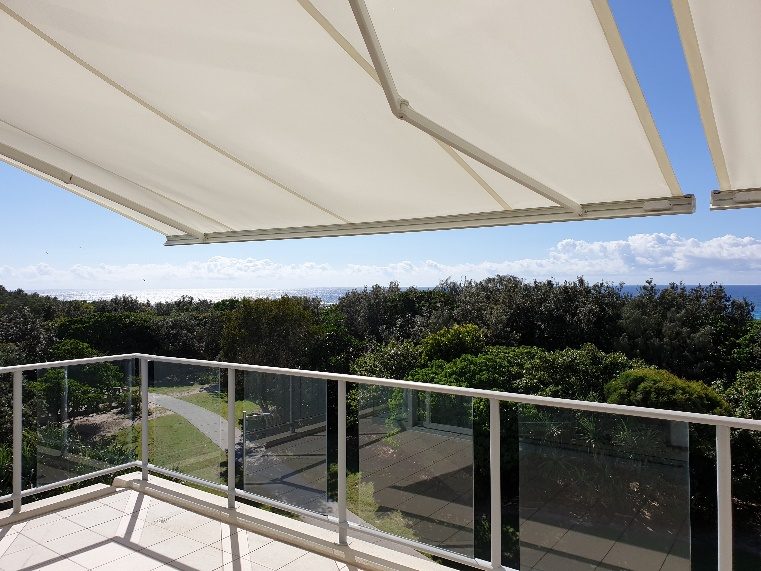
While standard retractable awnings extend and retract manually using a handle or hand crank, motorised retractable awnings can be programmed with a sensor, remote control, button, or motion trigger to automatically extend when the sun is harsh, or it starts to rain and retract when it is windy.
Besides giving a property an aesthetic edge, motorised awnings allow you to make use of the full space of a property without the interference of environmental factors. Although motorised awnings are perceived as being costly upfront, they save you time and money in the long run, especially as they retract and are stored away during bad weather which means less chance of damage and being longer-lasting than stationary awnings.
Motorised awnings are ideal for decks, patios, outdoor entertainment spaces.
Fabric types
All-weather Acrylic-coated and acrylic synthetic fabrics available in plain colours, patterns or stripes are proven to be most durable for retractable awnings solutions as it repels water and resists fading more effectively.
Benefits
- Expand outdoor living spaces
- Offers all weather protection
- Protection from damaging UV rays
- Improve aesthetics and the resale value of a property
- Cost-effective
- Reduced energy consumption and savings on utility bills
FIXED AWNINGS
aka Stationary awning, Permanent awning, Wall-mounted awning, Cantilevered awning
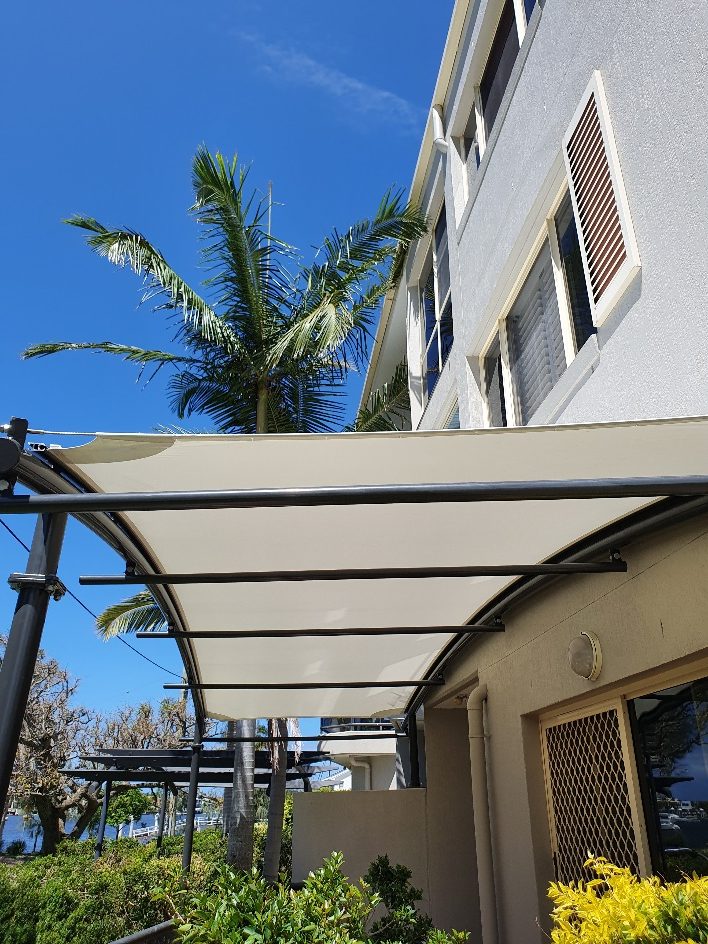
Fixed awnings are designed to be a permanent solution as they are attached in a fixed position to a wall above a doorways and windows, or over pools, and sturdily constructed to withstand the elements and provide constant protection all year round. With a variety of awning styles to choose from, from concave and convex to a dome and elongated dome, the finished awning can have a plain edge or a loose or fixed valance. Larger fixed awnings (or canopies) can provide protected outdoor areas for a business, cover a deck or patio, and extend living spaces.
Fixed awnings are ideal for above doorways, patio doors, windows, decks, and patios.
Fabric types
- Metal or aluminium fabrics are durable and relatively low maintenance, but can rust or dent
- Laminated vinyl is considered s standard awning fabric
- Coated vinyl is regarded as the most durable vinyl fabric available
Benefits
- Low maintenance
- Reduced energy consumption and savings on utility bills
- Enhance outdoor spaces
- UV protection
PORTABLE AWNINGS
Aka Freestanding awnings
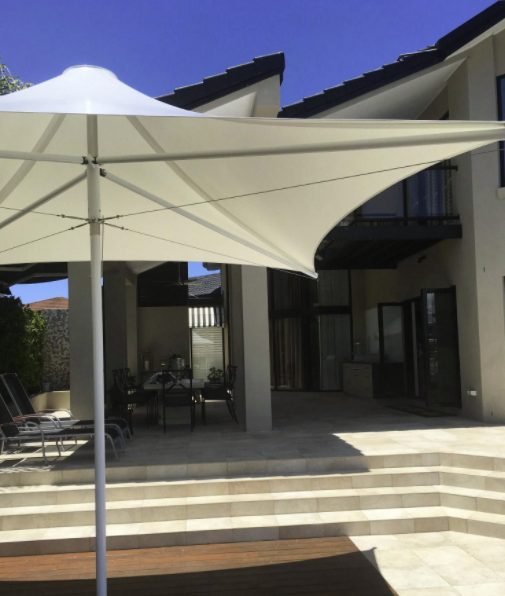
Portable awnings such as commercial umbrellas and canopies aren’t connected to a building which makes them less sturdy, yet they offer the flexibility of being moved depending on the sun’s path. For commercial buildings, portable outdoor awnings can also assist in business branding as the awning is typically the first point of contact customers have with your business.
Portable awnings are ideal for patios, decks, cars, outdoor camping, and pool areas.
Fabric types
- Waterproof Polyvinyl chloride (PVC) coated polyester membrane fabric – a strong, versatile, and flexible material that is 100% waterproof
- Waterproof PTFE or polytetrafluoroethylene – a woven fiberglass membrane that is extremely durable, waterproof, wind-resistant, and UV ray resistant
- Loosely woven polyester or even aluminium shade cloth
Benefits
- Low maintenance
- Minimises harmful rays
- Enhance outdoor spaces
- Flexibility to be moved where needed
Conclusion
With so many different types of commercial shade sails and awnings to choose from, it ultimately comes down to your requirements and working with a shade sail specialist that can design a custom solution that meet your needs and ensure perfect aesthetics and functionality that offers a good return on investment for your budget.
Share:
Jamie Howard - Director
Co-founder and Director Jamie has been hands-on in the shade and steel industry since leaving school. With over 15 years’ experience in shade, membrane and steel projects, Jamie is excited about the design opportunities shade structures offer in the commercial and industrial sectors. Jamie’s extensive design skills give him a competitive edge in situations with technical design complexity. He has won two personal industry awards for his designs, alongside many company-won awards.

